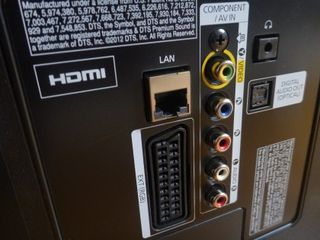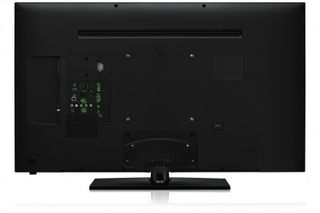Why you can trust TechRadar
Before we get into the UE42F5000's features, it's worth pondering that Samsung did, until this year, deal only in 40-inch TVs, so the extra two inches in 2013 are welcome, though hint at outsourcing.
Once considered a big-screen TV size, 42-inch is now pretty normal, thanks in part to the designers at Samsung squeezing LCD panels into ever-tighter designs. At just 49.4mm deep and with recessed edges, the UE42F5000 has a far smaller footprint than its forbears.
However, so small are current TV chassis that designers are clearly having more and more trouble fitting in the range of AV connectors we're used to. It's also apparent that the chassis used for the UE42F5000 is the exact opposite orientation to all others we've seen in 2013, with all of the ins and outs ranged on the side and back of the TV's right-hand side as it's viewed.

It's not a particularly impressive collection of ins and outs. The main concern in this department is the UE42F5000's measly two HDMI inputs, both of which are on a side-panel. They are, at least, easy to reach and swap over, and the panel itself is recessed more than enough to hide protruding connectors and cables. Sandwiched between the HDMI inputs is a lone USB 2.0 slot, while below is a Common Interface slot and an RF in to feed the Freeview HD tuner.
The dedicated rear panel – which is alarmingly flat, thus possibly disrupting any plans to hang the UE42F5000 flat to a wall – comprises a set of component video inputs and associated stereo phonos, a full RGB Scart for those stuck in the past, a digital optical audio output, and a wired Ethernet LAN slot, which not only flags up the UE42F5000's lack of Wi-Fi, but the absence of any web-fed dimension; that LAN is purely for firmware updates.

Technically, there's also a composite video input for owners of the Nintendo Wii or an older laptop; the green component connector has double duties.
It would have been far more convenient to swap over the RF in and the headphones jack, both of which are in woefully unsuitable spots. However, what really would have improved matters would have been a third HDMI slot. After all, the UE42F5000 might be throughly affordable, but at £400 it's hardly bargain basement.
Which is why we're increasingly demanding that all TVs have some element of digital file support. The UE42F5000 doesn't exactly disappoint here, though it's a second-rung treatment. Gone is the silky, joined-up integration of its higher-end TVs, replaced by a very basic page divided up into a choice of video, music and photos. Called ConnectShare, this basic user interface doesn't link to a home network (yes, it's rather mis-named) so the only way of getting digital files onto the UE42F5000 is via a USB stick or HDD.
Though it's good to see both Wide Colour Enhancer Plus and 100 Clear Motion Rate onboard, the latter isn't the anti-blur 100Hz mode it sounds like; it's actually a backlight blink that attempts to mimic the 100Hz effect – this is resolutely a basic 50Hz panel. Other picture tech includes Game mode and a Basic Sports mode.
Jamie is a freelance tech, travel and space journalist based in the UK. He’s been writing regularly for Techradar since it was launched in 2008 and also writes regularly for Forbes, The Telegraph, the South China Morning Post, Sky & Telescope and the Sky At Night magazine as well as other Future titles T3, Digital Camera World, All About Space and Space.com. He also edits two of his own websites, TravGear.com and WhenIsTheNextEclipse.com that reflect his obsession with travel gear and solar eclipse travel. He is the author of A Stargazing Program For Beginners (Springer, 2015),


